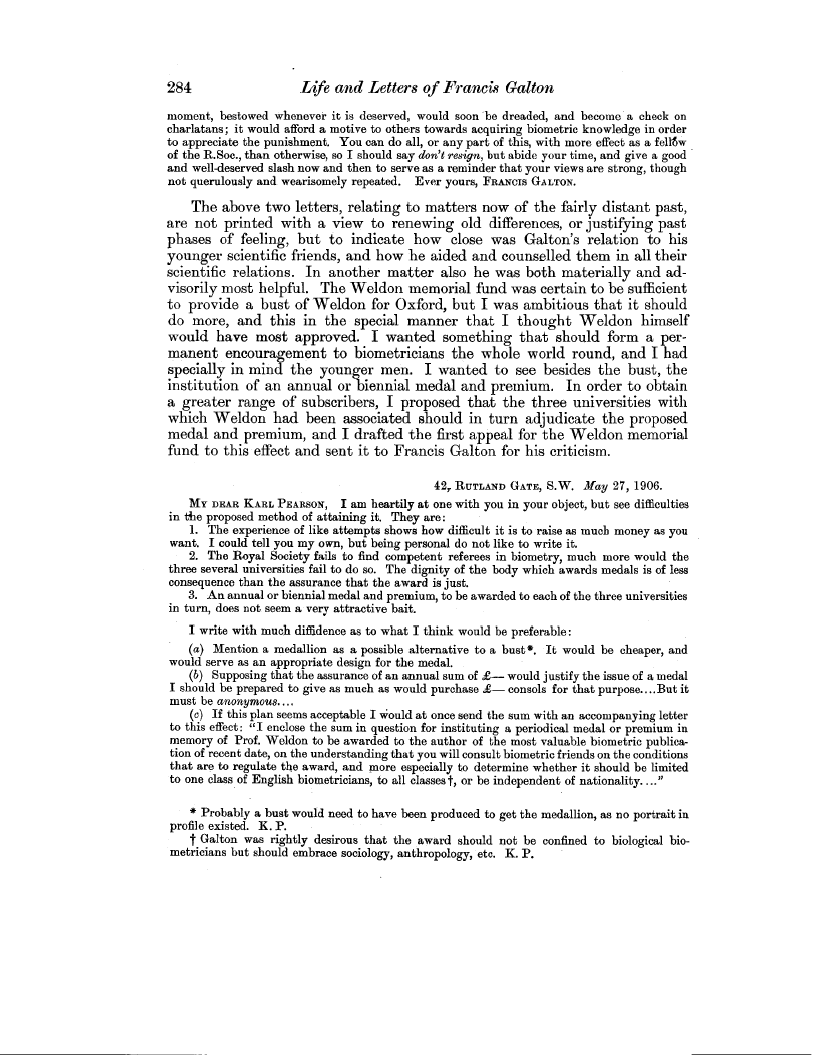| ||||||

OCR Rendition - approximate
284 Life and Letters of Francis Galton moment, bestowed whenever it is deserved, would soon be dreaded, and become a check on charlatans; it would afford a motive to others towards acquiring biometric knowledge in order to appreciate the punishment. You can do all, or any part of this, with more effect as a fellow of the R.Soc., than otherwise, so I should say don't resign, but abide your time, and give a good and well-deserved slash now and then to serve as a reminder that your views are strong, though not querulously and wearisomely repeated. Ever yours, FRANCIS GALTON. The above two letters, relating to matters now of the fairly distant past, are not printed with a view to renewing old differences, or justifying past phases of feeling, but to indicate how close was Galton's relation to his younger scientific friends, and how he aided and counselled them in all their scientific relations. In another matter also he was both materially and advisorily most helpful. The Weldon memorial fund was certain to be sufficient to provide a bust of Weldon for Oxford, but I was ambitious that it should do more, and this in the special manner that I thought Weldon himself would have most approved. I wanted something that should form a permanent encouragement to biometricians the whole world round, and I had specially in mind the younger men. I wanted to see besides the bust, the institution of an annual or biennial medal and premium. In order to obtain a greater range of subscribers, I proposed that the three universities with which Weldon had been associated should in turn adjudicate the proposed medal and premium, and I drafted the first appeal for the Weldon memorial fund to this effect and sent it to Francis Galton for his criticism. 42, RUTLAND GATE, S. W. May 27, 1906. MY DEAR KARL PEARSON, I am heartily at one with you in your object, but see difficulties in the proposed method of attaining it. They are: 1. The experience of like attempts shows how difficult it is to raise as much money as you want. I could tell you my own, but being personal do not like to write it. 2. The Royal Society fails to find competent referees in biometry, much more would the three several universities fail to do so. The dignity of the body which awards medals is of less consequence than the assurance that the award is just. 3. An annual or biennial medal and premium, to be awarded to each of the three universities in turn, does not seem a very attractive bait. I write with much diffidence as to what I think would be preferable: (a) Mention a medallion as a possible alternative to a bust*. It would be cheaper, and would serve as an appropriate design for the medal. (b) Supposing that the assurance of an annual sum of £- would justify the issue of a medal I should be prepared to give as much as would purchase £- consols for that purpose .... But it must be anonymous.... (c) If this plan seems acceptable I would at once send the sum with an accompanying letter to this effect: "I enclose the sum in question for instituting a periodical medal or premium in memory of Prof. Weldon to be awarded to the author of the most valuable biometric publication of recent date, on the understanding that you will consult biometric friends on the conditions that are to regulate the award, and more especially to determine whether it should be limited to one class of English biometricians, to all classes}, or be independent of nationality...." * Probably a bust would need to have been produced to get the medallion, as no portrait in profile existed. K. P. j' Galton was rightly desirous that the award should not be confined to biological biometricians but should embrace sociology, anthropology, etc. K. P.
|